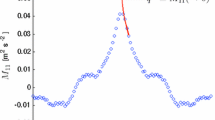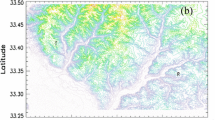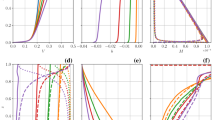Abstract
A comprehensive investigation is undertaken to discern the structure of momentum flux, turbulent kinetic energy, and scalar fluxes like heat, CO\(_2\), and H\(_2\)O in the atmospheric surface layer (ASL) at the Thumba Equatorial Rocket Launching Station—a coastal station on the west coast of southern peninsular India. The vertical transport, transfer efficiency, and dissimilarity between flux transport are studied as a function of stability using data collected over 1 year. The transfer efficiency for heat fluxes and momentum exhibits a strong dependence on stability (\(\zeta \)). However, the transfer efficiency of passive scalars CO\(_2\) and H\(_2\)O displays no apparent dependence on \(\zeta \). The correlation between fluxes and squared coherence estimates is evaluated to study the dissimilarity between flux transport. The correlation is strongest among momentum and heat fluxes and between CO\(_2\) and H\(_2\)O fluxes and shows a dependence on the prevailing stability conditions. However, the influence of stability is not evident for the various other combinations. The momentum and heat flux transport is dissimilar for unstable conditions, and it becomes similar during the transition from unstable to near-neutral conditions. The quadrant analysis is employed to study the contribution of different fluid motions to the aforementioned turbulent fluxes. Except for CO\(_2\) and H\(_2\)O fluxes, where all the quadrants have an equal contribution, ejections and sweeps are the dominating contributors for momentum and heat fluxes. The stability conditions greatly determine the ejection-sweep balance for heat flux, while some changes in duration and impact fraction are also detectable for momentum flux. Furthermore, contour maps of joint-probability function (JPDF) of vertical velocity fluctuations (\(w'\)) with streamwise velocity fluctuation (\(u'\)), temperature fluctuation (\(T'\)), and scalar fluctuations, respectively, are also presented. The dominance of the ejection and sweep cycles for turbulent fluxes provide evidence for the presence and importance of coherent structures in ASL.













Similar content being viewed by others
Data Availibility
The datasets analyzed during the current study are available from the corresponding author upon reasonable request.
References
Bergström H, Högström U (1989) Turbulent exchange above a pine forest II. Organized structures. Boundary-Layer Meteorol 49:231–263
Biltoft CA, Pardyjak ER (2009) Spectral coherence and the statistical significance of turbulent flux computations. J Atmos Oceanic Tech 26(2):403–409
Cantwell BJ (1981) Organized motion in turbulent flow. Annu Rev Fluid Mech 13:457–515
Choi T, Hong J, Kim J, Lee H, Asanuma J, Ishikawa H, Tsukamoto O, Zhiqiu G, Ma Y, Ueno K, et al. (2004) Turbulent exchange of heat, water vapor, and momentum over a tibetan prairie by eddy covariance and flux variance measurements. J Geophys Res Atmos 109(D21)
Chowdhuri S, Prabha TV (2019) An evaluation of the dissimilarity in heat and momentum transport through quadrant analysis for an unstable atmospheric surface layer flow. Environ Fluid Mech 19(2):513–542
Chowdhuri S, Prabha TV, Karipot A, Dharamraj T, Patil M (2015) Relationship between the momentum and scalar fluxes close to the ground during the Indian post-monsoon period. Boundary-Layer Meteorol 154:333–348
Coppin P, Raupach M, Legg B (1986) Experiments on scalar dispersion within a model plant canopy part II: an elevated plane source. Boundary-Layer Meteorol 35:167–191
De Bruin H, Kohsiek W, Van Den Hurk B (1993) A verification of some methods to determine the fluxes of momentum, sensible heat, and water vapour using standard deviation and structure parameter of scalar meteorological quantities. Boundary-Layer Meteorol 63(3):231–257
Farge M (1992) Wavelet transforms and their applications to turbulence. Annu Rev Fluid Mech 24(1):395–458
Finnigan J (2000) Turbulence in plant canopies. Annu Rev Fluid Mech 32(1):519–571
Foken T, Göockede M, Mauder M, Mahrt L, Amiro B, Munger W (2004) Post-field data quality control. In: Lee X, Massman W, Law B (eds) Handbook of micrometeorology. A guide for surface flux measurement and analysis. Kluwer Academic Publisher, Dordrecht, pp 181–208
Frenkiel FN, Klebanoff PS (1967) Higher-order correlations in a turbulent field. Phys Fluids 10(3):507–520
Katul G, Kuhn G, Schieldge J, Hsieh CI (1997) The ejection-sweep character of scalar fluxes in the unstable surface layer. Boundary-Layer Meteorol 83(1):1–26
Kline SJ, Reynolds WC, Schraub F, Runstadler P (1967) The structure of turbulent boundary layers. J Fluid Mech 30(4):741–773
Li D, Bou-Zeid E (2011) Coherent structures and the dissimilarity of turbulent transport of momentum and scalars in the unstable atmospheric surface layer. Boundary-Layer Meteorol 140(2):243–262
Li X, Bo T (2019) An application of quadrant and octant analysis to the atmospheric surface layer. J Wind Eng Ind Aerodyn 189:1–10
Lu S, Willmarth W (1973) Measurements of the structure of the Reynolds stress in a turbulent boundary layer. J Fluid Mech 60(3):481–511
Maitani T, Ohtaki E (1987) Turbulent transport processes of momentum and sensible heat in the surface layer over a paddy field. Boundary-Layer Meteorol 40(3):283–293
Narasimha R, Kumar SR, Prabhu A, Kailas S (2007) Turbulent flux events in a nearly neutral atmospheric boundary layer. Philos Trans R Soc A Math Phys Eng Sci 365(1852):841–858
Panofsky HA, Dutton JA (1984) Atmospheric turbulence. Models and methods for engineering applications. Wiley, New York
Raupach M (1981) Conditional statistics of Reynolds stress in rough-wall and smooth-wall turbulent boundary layers. J Fluid Mech 108:363–382
Raupach M, Coppin P, Legg B (1986) Experiments on scalar dispersion within a model plant canopy part I: the turbulence structure. Boundary-Layer Meteorol 35(1):21–52
Robinson S et al (1991) Coherent motions in the turbulent boundary layer. Annu Rev Fluid Mech 23(1):601–639
Schmutz M, Vogt R (2019) Flux similarity and turbulent transport of momentum, heat and carbon dioxide in the urban boundary layer. Boundary-Layer Meteorol 172(1):45–65
Shaw RH, Tavangar J, Ward DP (1983) Structure of the Reynolds stress in a canopy layer. J Appl Meteorol Climatol 22(11):1922–1931
Stull RB (1988) An introduction to boundary layer meteorology, vol 13. Springer, Berlin
Tyagi B, Satyanarayana A (2014) Coherent structures contributions in fluxes of momentum and heat at two tropical sites during pre-monsoon thunderstorm season. Int J Climatol 34(5):1575–1584
Wallace JM (2016) Quadrant analysis in turbulence research: history and evolution. Annu Rev Fluid Mech 48:131–158
Wang Y, Wang B, Lan C, Fang R, Zheng B, Lu J, Zheng D (2022) Improved quadrant analysis for large-scale events detection in turbulent transport. Atmosphere 13(3):489
Yue W, Meneveau C, Parlange MB, Zhu W, Van Hout R, Katz J (2007) A comparative quadrant analysis of turbulence in a plant canopy. Water Resources Res 43(5)
Zhu W, Van Hout R, Katz J (2007) PIV measurements in the atmospheric boundary layer within and above a mature corn canopy. Part II: quadrant-hole analysis. J Atmos Sci 64(8):2825–2838
Acknowledgements
The authors are grateful to the reviewers whose suggestions helped us improve the manuscript significantly. We would also like to acknowledge Dr.Anish Kumar M Nair, Dr.Mahesh C and Dileep P.K. and all the staff at Meteorology Facility, VSSC, ISRO, for their valuable discussions and support.
Funding
This research received no specific grant from the public, commercial, or not-for-profit funding agencies.
Author information
Authors and Affiliations
Contributions
The initial data analysis and figures, along with the first draft of the paper, were prepared by S.M. Further discussions on results and revision were done by A.C. and K.V.S.N.
Corresponding author
Ethics declarations
Conflict of interest
The authors declare that there is no conflict of interests regarding the publication of this paper.
Additional information
Publisher's Note
Springer Nature remains neutral with regard to jurisdictional claims in published maps and institutional affiliations.
Rights and permissions
Springer Nature or its licensor (e.g. a society or other partner) holds exclusive rights to this article under a publishing agreement with the author(s) or other rightsholder(s); author self-archiving of the accepted manuscript version of this article is solely governed by the terms of such publishing agreement and applicable law.
About this article
Cite this article
Maurya, S., Chandrasekar, A. & Namboodiri, K.V.S. A Quantitative Study of Turbulent Fluxes over a Coastal Station. Boundary-Layer Meteorol 188, 55–74 (2023). https://doi.org/10.1007/s10546-023-00802-4
Received:
Accepted:
Published:
Issue Date:
DOI: https://doi.org/10.1007/s10546-023-00802-4




